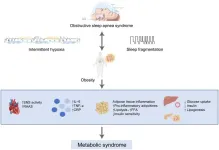(Press-News.org)
Cardiovascular diseases remain a leading cause of mortality globally, particularly among individuals with both obstructive sleep apnea (OSA) and metabolic syndrome (MetS). These two conditions exacerbate each other, creating a vicious cycle that increases the risk of cardiovascular diseases. Understanding the pathophysiological relationship between OSA and MetS is crucial for developing effective prevention and treatment strategies. This review explores current knowledge on the connection between OSA and MetS and discusses the progress in treatment options.
Concepts and Epidemiology of OSA and MetS
OSA is characterized by repeated upper airway collapse during sleep, leading to intermittent hypoxia and fragmented sleep patterns. Affecting 14% of the global population, OSA is more prevalent among adults aged 30–69. Symptoms include daytime sleepiness, memory issues, and headaches, significantly reducing patients' quality of life.
MetS is a cluster of metabolic abnormalities that include central obesity, high blood pressure, dyslipidemia, and insulin resistance. The prevalence of MetS is estimated at 24% in the U.S., with obesity being a key contributing factor.
The Relationship Between OSA and MetS
OSA and MetS share common risk factors like obesity and aging, and they often coexist. Studies show that patients with severe OSA are more likely to have MetS, and vice versa. The bidirectional nature of their relationship suggests that these conditions reinforce each other, further aggravating metabolic and cardiovascular risks. Obesity, particularly visceral fat, plays a central role in worsening OSA, while OSA exacerbates metabolic disturbances through intermittent hypoxia and sympathetic nervous system activation.
The Correlation Between OSA and Obesity
Visceral fat accumulation in obese individuals significantly increases the risk of OSA. Research shows that obese individuals with OSA have larger visceral fat areas compared to those without OSA. Hormonal disruptions, including lowered leptin levels and increased ghrelin levels, are associated with OSA and contribute to heightened appetite and further weight gain.
The Connection Between OSA and Hypertension
OSA is strongly associated with hypertension. The intermittent hypoxia seen in OSA triggers increased sympathetic nervous activity, which leads to spikes in blood pressure and disrupts the natural nocturnal “dipping” pattern of blood pressure. This effect contributes to elevated cardiovascular risks among OSA patients.
The Connection Between OSA and Diabetes
OSA is linked to an increased risk of developing type 2 diabetes mellitus (T2DM). Intermittent hypoxia impairs glucose regulation and insulin sensitivity, contributing to the development and worsening of T2DM. OSA patients also experience elevated inflammatory cytokine levels, which are associated with insulin resistance.
The Connection Between OSA and Dyslipidemia
Dyslipidemia is common in OSA patients, with studies showing reduced levels of high-density lipoprotein (HDL) and increased triglycerides (TG) and low-density lipoprotein (LDL) levels. Intermittent hypoxia and heightened sympathetic activity contribute to these lipid abnormalities, further increasing the risk of cardiovascular diseases.
The Influence of Various Treatments on MetS and Its Components
Continuous positive airway pressure (CPAP) therapy is the primary treatment for OSA. While CPAP effectively alleviates OSA symptoms, its impact on MetS components is limited. CPAP has shown modest effects in reducing blood pressure, total cholesterol, and insulin resistance, but long-term improvements in metabolic markers are often insufficient.
Weight management and lifestyle interventions remain critical for reversing MetS. Combining CPAP with weight loss strategies has been shown to improve inflammatory markers, insulin sensitivity, and triglyceride levels. Metabolic surgeries, such as gastric bypass, offer more substantial improvements in both OSA symptoms and metabolic health by addressing the root cause of obesity.
For patients with mild to moderate OSA, mandibular advancement devices (MADs) provide an alternative treatment option. MADs improve sleep quality and may help reduce blood pressure, though their impact on metabolic markers is less significant.
Conclusions
OSA and MetS form a complex, mutually reinforcing cycle that significantly elevates cardiovascular risks. Breaking this cycle through weight management, lifestyle interventions, and targeted therapies like CPAP and metabolic surgery can improve patient outcomes. However, more research is needed to fully understand the metabolic benefits of these treatments and optimize care for patients with both OSA and MetS.
Full text
https://www.xiahepublishing.com/0000-0000/CMD-2024-00003
The study was recently published in the Chronic Metabolic Diseases
Chronic Metabolic Diseases (CMD) is dedicated to advancing our knowledge of the epidemiology, pathophysiology, prevention, and treatment of chronic metabolic diseases. We publish works from basic biomedical to translational and clinical research on metabolism.
CMD’s scope includes obesity, diabetes, fatty liver, atherosclerosis, osteoporosis, dyslipidemia, and gout. Studies elucidating metabolic changes in tumorigenesis and ageing are also welcome, which sheds light on identifying novel pharmacological targets for cancer or ageing. To promote cross-disciplinary research and collaboration, we publish works of interest to researchers both within and outside the immediate field.
Follow us on X: @xiahepublishing
Follow us on LinkedIn: Xia & He Publishing Inc.
END
Chimpanzees are known for their remarkable intelligence and use of tools, but could their cultures also evolve over time like human cultures? A new, multidisciplinary study led by the University of Zurich suggests that some of their most advanced behaviors may have been passed down and refined through generations.
In recent decades, scientists have clearly demonstrated that chimpanzees, like humans, pass on complex cultures such as tool use from generation to generation. But human culture has become vastly more sophisticated, ...
By providing flexibility services to renewable energy systems, consumers can both help in balancing power grids and receive financial benefits. Hosna Khajeh’s doctoral dissertation from the University of Vaasa, Finland, introduces new methods that enable the efficient utilisation of energy users’ flexibility resources in distribution and transmission networks.
As the use of weather-dependent renewable energy sources increases, power systems need to become more flexible to guarantee energy supply at all times. One of the necessary steps for the future is making it possible for consumers to support both national and local power grids with ...
Factors beyond carbohydrates have a substantial influence on blood glucose levels meaning current automated insulin delivery systems miss vital information required for glucose regulation, a new study has found.
A team of researchers from the University of Bristol analysing automated insulin delivery data from people with Type 1 Diabetes (T1D) discovered that unexpected patterns in insulin needs are just as common as well-established ones.
The study, published today in JMIRx Med aimed to identify patterns in changes of insulin needs and to analyse how frequently these occur in people with T1D who use the OpenAPS, a state-of-the-art, ...
Solid oxide cells (SOCs), including solid oxide fuel cells (SOFCs) and solid oxide electrolysis cells (SOECs), are among the most promising energy conversion technologies due to their high efficiency and fuel flexibility. However, the high-temperature sintering required for their manufacture often leads to undesirable reactions at the electrolyte and electrode interface, degrading cell performance. A thin, dense ceria-based barrier layer, typically composed of gadolinium-doped ceria (GDC), is widely used to prevent these reactions. Achieving sufficient densification ...
The Ministry of Science and ICT (MSIT), headed by Minister Yoo Sang-im, held the launch ceremony for the "AI Safety Institute" (AISI) on Wednesday, November 27, at the Pangyo Global R&D Center.
At the "AI Seoul Summit"last May, leaders from 10 countries recognized safety as a key component of responsible AI innovation and emphasized the importance of establishing AI safety institutes and fostering global collaboration for safe AI. President Yoon Suk Yeol also expressed his commitment, stating, "We will work towards establishing an AI safety institute in Korea and actively participate ...
Exposure to air pollutants (PM2.5 and PM10) is associated with an increased risk of persistent long-COVID symptoms, partly due to its impact on the severity of the acute infection. This is the main conclusion of a study led by the Barcelona Institute for Global Health (ISGlobal), a centre supported by “la Caixa” Foundation, in collaboration with the Germans Trias i Pujol Research Institute (IGTP), and published in Environmental Health Perspectives.
Long-COVID is a heterogeneous condition in which symptoms like fatigue, breathlessness, and cognitive issues persist for months after ...
CHICAGO – Soccer heading may cause more damage to the brain than previously thought, according to a study being presented next week at the annual meeting of the Radiological Society of North America (RSNA).
Heading is a widely used technique in soccer where the players control the direction of the ball by hitting it with their head. In recent years, research has been done that suggests a link between repeated head impacts and neurodegenerative diseases, such as chronic traumatic encephalopathy (CTE).
“The potential effects of repeated head impacts in sport are ...
A new study has linked distinct neural and behavioral characteristics in autism spectrum disorder to a simple computational principle. Centered on the “dynamic range” of neurons, which reflects how gradually or sharply they respond to input, the study suggests that individuals with autism spectrum disorder have an increased dynamic range in their neuronal response, resulting in a more detailed but slower response to changes. This research defies previous descriptions of ASD as a “broken cog in the machine” and provides a deeper, richer account of the computational basis of ASD.
[Hebrew University of Jerusalem]– Researchers Dr. Yuval Hart and Oded ...
Large language models, a type of AI that analyses text, can predict the results of proposed neuroscience studies more accurately than human experts, finds a new study led by UCL (University College London) researchers.
The findings, published in Nature Human Behaviour, demonstrate that large language models (LLMs) trained on vast datasets of text can distil patterns from scientific literature, enabling them to forecast scientific outcomes with superhuman accuracy.
The researchers say this highlights ...
As we age, our cognitive and motor functions deteriorate, which in turn affects our independence and overall quality of life. Research efforts to ameliorate or even completely abolish this have given rise to technologies that show a lot of promise.
Among these is non-invasive brain stimulation: a term encompassing a set of techniques that can affect brain functions externally and noninvasively, without the need for surgery or implants. One such promising technique, in particular, is anodal transcranial direct current stimulation (atDCS), which uses ...



